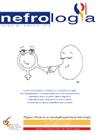西班牙肾脏疾病登记:2022年报告和进化分析
IF 2
4区 医学
Q2 UROLOGY & NEPHROLOGY
引用次数: 0
摘要
到2100年,慢性肾脏疾病(CKD)将成为西班牙第二大死因。西班牙肾脏疾病登记处(REER)记录了西班牙所有需要肾脏替代治疗(RRT)的患者的发病率、患病率和死亡率。方法数据由西班牙各自治区、市和Organización国家移植中心提供。计算了2013-2022年期间我国RRT患者的发病率和患病率(考虑到西班牙人口,根据国家研究所Estadística的年度数据)以及RRT患者的死亡率。结果2013 - 2019年,RRT发病率上升21%,此后稳定,2022年为152.2例/百万人口(pmp),其中血液透析(HD)占77.8%,腹膜透析(PD)占16.7%,肾移植占5.5%。糖尿病是CKD需要RRT的主要原因(21.8%),其次是其他原因(21.6%)。男性RRT的发病率比女性高2倍,地区差异很大(在发病率最高和最低的地区,男性为1.93倍,女性为2.55倍)。2022年,RRT的患病率为1391.1 pmp,在过去十年中呈渐进式增长,主要是以移植人群的增加为代价(765.0 pmp, 55.0%)。2022年,西班牙进行了3404例肾脏移植手术(71.7例),这使其处于世界领先地位。最常见的供体类型是神经系统死亡后的供体(51.5%),其次是循环系统死亡后的供体(37%)。RRT患者的年总死亡率为8.4% (HD为13.8%,PD为10.1%,移植为3.9%)。结论西班牙RRT的发病率和流行率虽然近年来有所稳定,但仍在持续上升。必须采取其他措施来协调和优化肾脏保健。本文章由计算机程序翻译,如有差异,请以英文原文为准。
Registro Español de Enfermos Renales (REER): informe del año 2022 y análisis evolutivo
Introduction
Chronic kidney disease (CKD) will be the second leading cause of death in Spain by 2100. The Spanish Renal Disease Registry (REER) records the incidence, prevalence and mortality of all patients requiring renal replacement therapy (RRT) in Spain.
Methods
Data are provided by Spanish autonomous regions and cities and the Organización Nacional de Trasplantes. Incidence and prevalence rates of RRT have been calculated (considering the Spanish population according to annual data from the Instituto Nacional de Estadística), as well as mortality of patients on RRT in our country during the period 2013-2022.
Results
The incidence rate of RRT increased by 21% from 2013 to 2019, and stabilized thereafter, with a value of 152.2 cases per million population (pmp) in 2022, of which 77.8% were on haemodialysis (HD), 16.7% on peritoneal dialysis (PD) and 5.5% received a preemptive kidney transplant. Diabetes was the leading cause of CKD requiring RRT (21.8%), followed by other causes (21.6%). The incidence rate of RRT was 2-fold higher in men than in women, with large regional differences (1.93-fold for men and 2.55-fold for women in regions with the highest and lowest incidence rates).
The prevalence rate of RRT was 1,391.1 pmp in 2022, showing a progressive increase over the last decade, mainly at the expense of an increase in the transplant population (765.0 pmp, 55.0%).
In 2022, 3,404 kidney transplants were performed in Spain (71.7 pmp), which situates it as a world leader. The most frequent donor type was the donor after the neurological determination of death (51.5%), followed by the donor after the circulatory determination of death (37%).
The overall annual mortality of RRT patients was 8.4% (13.8% for HD, 10.1% for PD and 3.9% for transplantation).
Conclusions
Although it has stabilized somewhat in recent years, the incidence and prevalence of RRT continues to rise in Spain. Additional measures must be adopted to harmonize and optimize kidney health care.
求助全文
通过发布文献求助,成功后即可免费获取论文全文。
去求助
来源期刊

Nefrologia
医学-泌尿学与肾脏学
CiteScore
3.40
自引率
7.70%
发文量
148
审稿时长
47 days
期刊介绍:
Nefrología is the official publication of the Spanish Society of Nephrology. The Journal publishes articles on basic or clinical research relating to nephrology, arterial hypertension, dialysis and kidney transplants. It is governed by the peer review system and all original papers are subject to internal assessment and external reviews. The journal accepts submissions of articles in English and in Spanish languages.
 求助内容:
求助内容: 应助结果提醒方式:
应助结果提醒方式:


